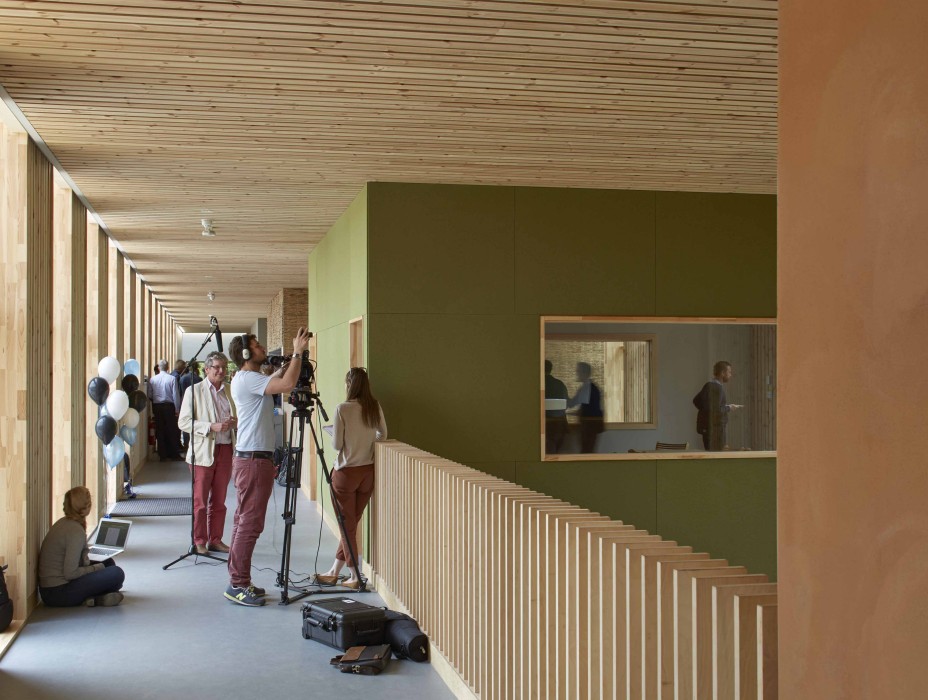Architype
A Look Back At 2015
By Jessica Taylor

What a year 2015 has been for the practice! Several high profile projects completed, the results and dissemination from a year in-house research into our Passivhaus schools, and a shelf of new awards for our contribution to the industry, to name just a few highlights.
One of the biggest changes came in the spring, when Bob Hayes, director of Architype for 30 years stepped down as a director. Several years in the planning, the handover brought a number of changes to our structure, with co-director, Jonathan Hines moving to a central managing director role, and two new directors appointed in each office, Ben Humphries in London and Mark Barry in the Hereford Office. The decision was also taken to introduce employee ownership in-line Architype’s collaborative ethos (via an Employee Trust as at John Lewis), which became a reality in the December; with an initial 30% ownership. The practice aims to be majority employee owned within the next 15 years. The shift was of course marked by the best party of 2015, featuring in-house entertainment tributes to Bob, including an alternative music video and acapella singing group!
On to completed projects, January saw the handover of the UK’s first Passivhaus archive facility, Herefordshire Archive and Records Centre; a scheme that has been highly celebrated and furnished with no less than 3 awards to date; including RIBA West Midlands Award and two Constructing Excellence Awards for ‘Best Value Project’ and ‘Best Sustainable Project’ 2015. Achieving Passivhaus is set to save the client around £60,000 a year in utility costs and has helped to fulfil the requirements of PD5454:2012, the new British Standard for Archives which requires temperatures and air conditions to be maintained within strict parameters.
Next to complete was the first phase of the eagerly anticipated, St. Michael’s Hospice, a project that has been with the practice since 2010. The new in-patient wing provides free care for people in Herefordshire, in a state-of-the-art building, which has re-imagined the needs of palliative care. Staff, patients and visitors alike are delighted with the new building, which has really changed lives, and has helped nurses and volunteers give more effective care. The second phase, a refurbishment of the existing building, is due to complete this spring and will form the day care and training provision for this independent charity.
A key focus for industry peers and media over the summer, the handover of the University of East Anglia’s Enterprise Centre, placed Architype firmly in the spotlight for this ambitious and ground-breaking project. Achieving robust Passivhaus design, BREEAM Outstanding, an exemplary low-carbon specification and a 100-year performance life span, the building has been dubbed by press as ‘the UK’s greenest building’. The learning from this project over the forthcoming years, and indeed beyond, will no doubt inform Architype’s team in their continuous development of sustainable design and Passivhaus across sectors.
During the year, Architype rolled out a series of seminars, covering our approach to Passivhaus, sharing stories, Passivhaus projects and lessons learned. Opinions came from a compelling list of invited speakers, from project managers and contractors who have worked with the practice, to the clients themselves. A broad variety of guests attended seminars in Birmingham, London and finally Cardiff in December, which coincided with the official opening of Architype designed Burry Port Community Primary School, Wales’s first Passivhaus school.
One of the most intriguing elements of the seminar series has been the first reveal of Architype’s results from a year of research, undertaken by the practice’s full-time researcher, Chryssa Thoua. Chryssa has been monitoring the thermal comfort of 5 occupied Architype schools, including pre-Passivhaus schools, (St. Luke’s and The Willows); first-generation Passivhaus schools, (Oak Meadow Primary and Bushbury Hill Primary,) and second-generation school, Wilkinson Primary School. Some compelling results have been unearthed from the collection of comparable data from a control classroom in each school throughout the year, as well as monitoring the same factors in a standard 1970s school classroom built to UK Building Regulations. Not only has Architype managed to demonstrate a progressive improvement in building performance from project to project, but we have been able to prove, with real data, the environmental benefits and energy savings of Passivhaus compared to non Passivhaus schools. These are great results for the practice and provide good evidence for Passivhaus in the UK.
This was perhaps one of Architype’s most persuasive elements of their submission to the Passivhaus Trust Awards this year, for which we won the ‘Large Projects’ category with Wilkinson Primary School. A building demonstrating solutions to lessons learned, as well as a collaborative synergy with the partnering team and users alike, Wilkinson is a benchmark exemplar project for Passivhaus education buildings.
Another major award scoop for the practice was the Architects Journal Top 120 Architects Sustainable Practice of the Year 2015. Impressed by Architype’s 30-year history of continuous sustainable design, it was the practice’s overall commitment and approach to sustainability, including social and economic aspects as well as the environmental and Passivhaus credentials that clinched the award. Not the only award from the AJ in 2015, Architype was shortlisted twice by the AJ Retrofit Awards for two of our refurbished school schemes in London, Camden Centre for Learning and the Robert Fitzroy Academy, which was the eventual and deserved winner.
As the scope and reputation of the practice continues to grow, 2015 has been a busy year for our team who have been invited to speak at several high profile conferences to share our knowledge. Jonathan Hines, Managing Director of the practice was this year’s chair of the UK Passivhaus conference in London, and was joined by colleagues and Architype guest speakers Lee Fordham and Chryssa Thoua. Jonathan was also invited to speak at the North American Passivhaus Conference in Vancouver this October, where the standard is growing in success and popularity. The autumn was also an opportunity to showcase The Enterprise Centre at the Education Estates Conference in Manchester, which Ben Humphries was invited to speak at. Following the conference, the project was highly commended as project of the year by the Education Estates Awards 2015. Mark Lumley meanwhile was invited to speak the annual RIBA Research Symopsium in November, where he spoke about our experience in post-occupancy monitoring, as reviewed in RIBA Journal this month.
The final good news story for the year came from The London Borough of Lewisham in the autumn, who awarded The Rural Urban Synthesis Society (RUSS) Passivhaus self-build scheme the winning bid for a brownfield site in Church Grove, Lewisham. As the architects behind the design, in collaboration with Jon Broome Architects, the 33 mixed tenure residential scheme is a return to Architype’s origins in self-build, integrated with the practices modern Passivhaus approach. The Church Grove site is a sustainable example of how to combat the London housing crisis.
2016 is set to be another eventful year, Highgate Junior School finishing on site, design development of a large passive extra care scheme in Exeter, and commencing on site with the UK’s largest Passivhaus housing project, Bridgecroft Residential Development to name a few known highlights. Come back and visit the Archiblog for more updates!
Happy New Year!
